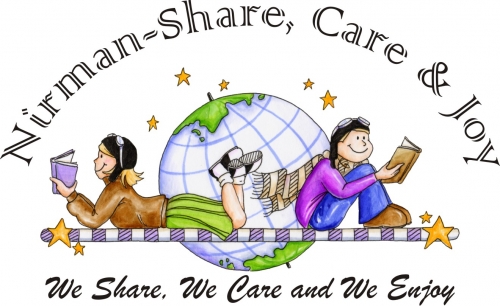Class VII: Chapter 3 - Our Changing Earth
Objectives and Goals:
- Pangaea.
- The Continental Drift Theory.
- The Theory of Plate Tectonics.
- The forces active behind the changes on the earth.
- The Lithospheric Plates.
- The Tectonic Movements.
- Endogenic (Internal) and Exogenic (External) Forces.
- The Earth Movements.
- The Volcanoes.
- Three different types of volcanoes (i.e. Active, Dormant and Extinct).
- Earthquakes. Instrument used to measure an earthquake.
- The major landforms. Weathering, Erosion, Aggradations and Degradation.
- Work of a river and features formed by a river.
- Work of ice and features formed by ice.
- Work of wind and features formed by wind.
- Work of waves and features formed by waves.
Some important points to remember: -
- Forces like earthquake and volcanoes occurs beneath the earth's crust.
- Forces like weathering, erosion, etc. are responsible for the changes on the earth's surface.
- Forces are of two types: Endogenic (Internal) and Exogenic (External) forces.
(a) Endogenic (Internal) Forces: Forces which form mountains, plateaus, plains, rising & sinking of coastal plains, movement of continental blocks, etc. These are slow and sudden forces. Internal forces are: -
(i) Earth Movements
(ii) Earthquakes
(iii) Volcanoes
(b) Exogenic (External) Forces: These forces originate on earth and form new landforms on the earth's surface. External forces such as: -
(i) Changes in atmospheric conditions.
(ii) Rivers, glaciers, sea waves and winds.
Earth Movements:
Earth's crust or lithosphere consists of several lithospheric plates.Surface of Earth changes as the lithospheric plates moves.Earth movements arise inside the earth.Temperature and pressure inside the earth changes causes changes on the earth's surface.
According to the theory of continental drift, the world was made up of a single continent through most of geologic time. That continent eventually separated and drifted apart, forming into the seven continents we have today. The first comprehensive theory of continental drift was suggested by the German meteorologist Alfred Wegener in 1912.
Million of year also there was a single continent named "Pangaea". Pangaea broke into pieces due to internal forces and is drifting away from each other since last almost 250 million years.Two landmasses – "Laurasia in North" and "Gondwanaland in South". Both the landmasses were separated by a shallow sea called "Tethys Sea".Size of Tethys Sea kept on decreasing due to movement of landmasses towards each other, thus, resulting in the formation of the young fold mountains "Himalayas".
Theory of Plate Tectonics:
The continental blocks or the plates are floating on mantle. They move with the change or release of pressure and temperature inside the earth.Tectonic movements are of two types:
(a) Vertical Movement: Causes land to uplift or subside or both.
(b) Horizontal Movement: Formation of mountains, trenches in the sea, widening of water bodies, etc. Such movements can cause both folding and faulting of structure.
Folding:
Caused by compression, when blocks of landforms come closer to each other, they form wrinkles or folds on the earth's surface. E.g. the young fold mountains 'Himalayas'. These young fold mountains are formed by sedimentary rocks.
Faulting:
The structure of rocks cracks or breaks along the weaker areas due to tension, this is called faulting. This may cause upliftment and subsidence of land and can form Block Mountains. E.g. Vindhyas and Satpura hills.When a part of land subsides between two faults, it forms Rift Valley. Narmada & Tapti Rivers flow through the rift valley.
Earthquakes:
- The crust of the earth has cracks in it called the 'Faults'.
- The study of earthquake shocks and its effects is called 'Seismology'.
- Instruments used to records the shaking of land is known as 'Seismograph'.
- The vibrations are called Seismic Waves.Earthquake is measured from 1 to 10 on the Richter Scale.
- The point of origin of an earthquake is called its 'Focus'.
- The point directly/vertically above the focus on the earth's surface is known as 'Epicenter'.
- The scientists who study earthquake is known as 'Seismologists'.
Effects of earthquakes:
- Displacement of the earth's crust (uplifts and subsides).
- Results in landslides and avalanches in mountainous regions.
- Destruction done by earthquakes can be seen like, falling of buildings, damaged roads, communication system, etc.
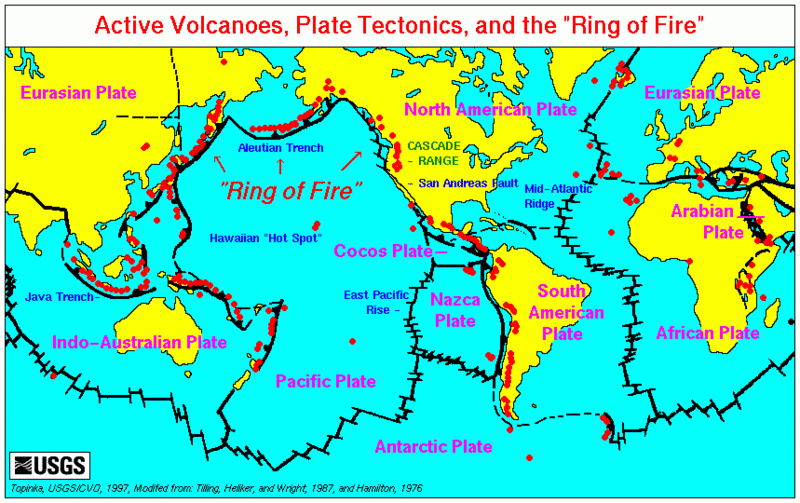
Volcanoes:
- Natural openings in the earth's crust through which molten materials, rocks, ashes, gases, etc are thrown out are called 'Volcanoes'.
- Volcanoes erupt due to excessive 'heat and pressure' inside the earth.
- The opening through which lava comes out is called 'Vent of Volcano'.
- The funnel shaped depression at the top of the vent is called 'Crater'.
- Around the Pacific Ocean along the belt of volcanoes called 'Ring of Fire'.
- About 68% of volcanoes occur in this region.
- Lava ejected by volcanoes can be thick or thin in nature.
Volcanoes are classified into three types: -
(a) Active Volcanoes: These volcanoes erupt frequently and give out gases, ash, lava, etc. e.g. Around Pacific Ocean, Hawaii Islands, etc.
(b) Dormant Volcanoes: These are also known as 'Sleeping Volcanoes'. They erupt after a very long time. E.g. Mt. Vesuvius in Italy.
(c) Extinct Volcanoes: These are also known as 'Dead Volcanoes'. They have been inactive since a very long time. E.g. Mt. Kilimanjaro in East Africa.
MAJOR LAND FORMS
- The landscape is being continuously changing away by two processes – weathering and erosion.
- Weathering is the breaking up of the rocks on the earth's surface.
- Erosion is the wearing away of the landscape by different agents like water, wind and ice.
- The eroded material is carried away or transported by water, wind, etc. and eventually deposited.
- This process of erosion and deposition create different landforms on the surface of the earth.
- The process of reduction of height of landform is called 'degradation'.
- The process of depositing the eroded material is called 'aggradation'.
Work of a River: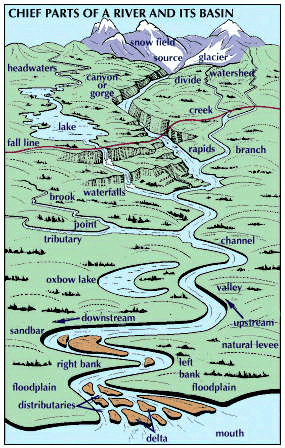
1. Rivers are the most important agents of degradation.
2. Work of the river depends on two factors: -
(a) The volume of Water. (b) Slope of river beds.
3. Common features formed by river while flowing through mountains: -
(a) 'I', 'V' shaped valley. (b) Gorges or Canyons (deep valleys)
(c) Waterfalls, etc.
4. Common features formed by river while flowing through plains: -
(a) Meanders (curves & large bends or loops) (b) Oxbow Lakes
(c) Flood Plains (e) Levees (slightly raised river banks)
5. Common features formed by river when it reaches near the sea: -
(a) River breakup into various streams called 'distributaries'.
(b) Delta
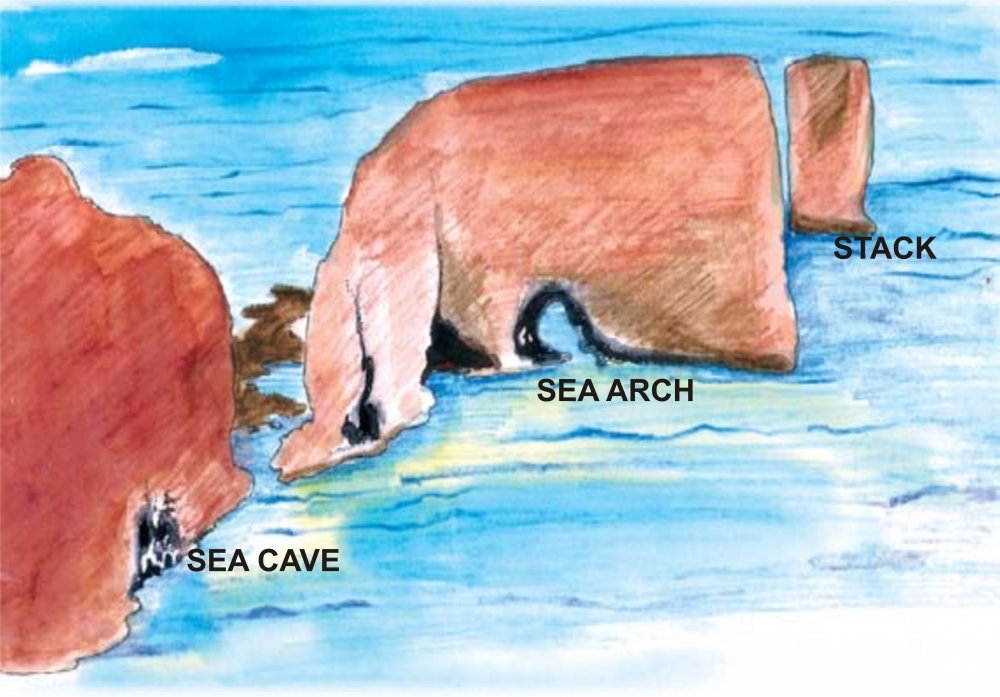
Work of Sea Waves
- The erosion and deposition of the sea waves gives rise to coastal landforms.
- Sea waves continuously strike at the rocks. Cracks develop. Over time they become larger and wider. Thus, hollow like caves are formed on the rocks. They are called sea caves.
- When these cavities become bigger and bigger only the roof of the caves remain, thus forming sea arches.
- Further, erosion breaks the roof and only walls are left. These wall like features are called stacks.
- The steep rocky coast rising almost vertically above sea water is called sea cliff.
- The sea waves deposit sediments along the shores forming beaches.
Work of Ice
- Glaciers are "rivers" of ice which too erode the landscape by bulldozing soil and stones to expose the solid rock below.
- Glaciers carve out deep hollows. As the ice melts they get filled up with water and become beautiful lakes in the mountains.
- Formation of "U" shaped valleys, which are deep and have steep sides.
- The material carried by the glacier such as rocks big and small, sand and silt gets deposited. These deposits form glacial moraines.
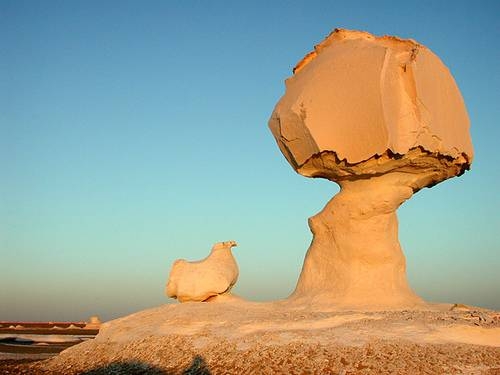
Work of Wind
- An active agent of erosion and deposition in the deserts is wind.
- In deserts you can see rocks in the shape of a mushroom, commonly called mushroom rocks.
- Winds erode the lower section of the rock more than the upper part. Therefore, such rocks have narrower base and wider top.
- When the wind blows, it lifts and transports sand from one place to another. When it stops blowing the sand falls and gets deposited in low hill – like structures. These are called sand dunes.
- When the grains of sand are very fine and light, the wind can carry it over very long distances.
- When such sand is deposited in large areas, it is called loess. A large deposit of loess is found in China.
-----x-----X-----x-----
I Love Living Life I Am Happy, Inspirational Video
Resources & Study Material for The Green Olympiad

For Sample question paper:
- http://www.teriin.org/olympiad/pdf/green-olympiad.pdf
Links to important websites:
- http://www.enviropaedia.com/
- http://www.unep.org
- http://www.pitara.com/activities/quiz/online.asp?qname=environment
- http://www.unep.org/iyb
- http://www.cbd.int
- http://www.iucnredlist.org
Q1. What is the GREEN Olympiad?
Ans: The GREEN Olympiad is India's first annual examination on environmental issues for middle and senior school students. The examination is designed innovatively to test the knowledge of students and also educate and sensitize them in the process. One of its kind in India, the GREEN Olympiad asks questions on air and water pollution, environment-friendly initiatives and practices, land and water resources, forests, wildlife, oceans, socio-economic aspects of natural resources, global climate change, and the roles of society to improve our environment.
Q2. How do I prepare for the examination?
Ans: There are various ways to brush up your knowledge. Read as many articles as you can on environmental issues in magazines, newspapers, books, journals, encyclopedias. You can watch channels such as Discovery, Animal Planet, National Geographic, etc., on television. Besides this, you could also order a copy of 'Enviro-Challenge': a well-researched question bank containing over 500 questions on diverse topics on environment or you can visit on the websites (link given above).
With Best Wishes
Best Wishes to all Class VIII Students

